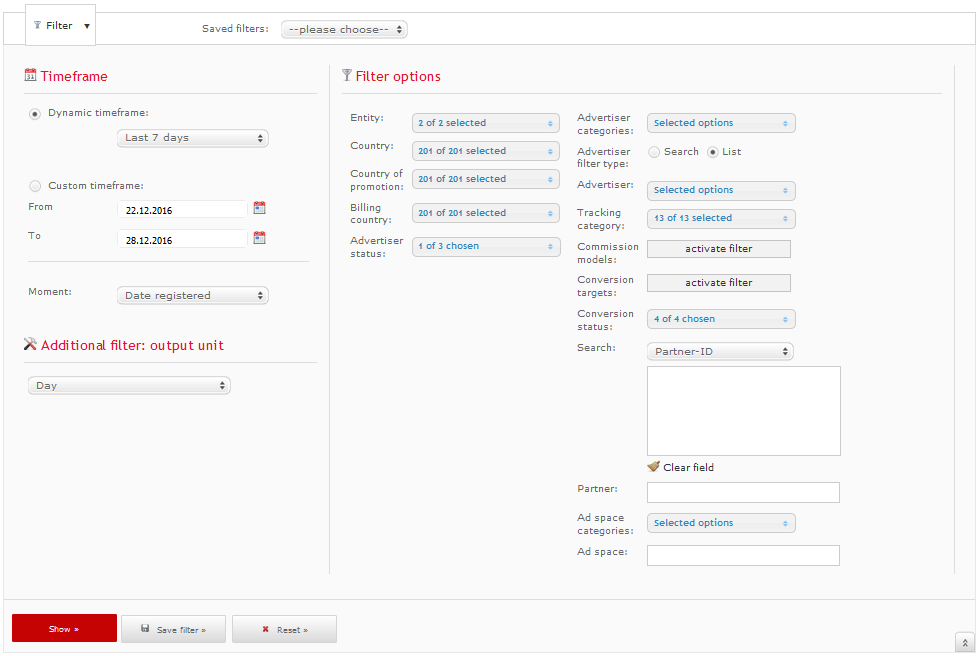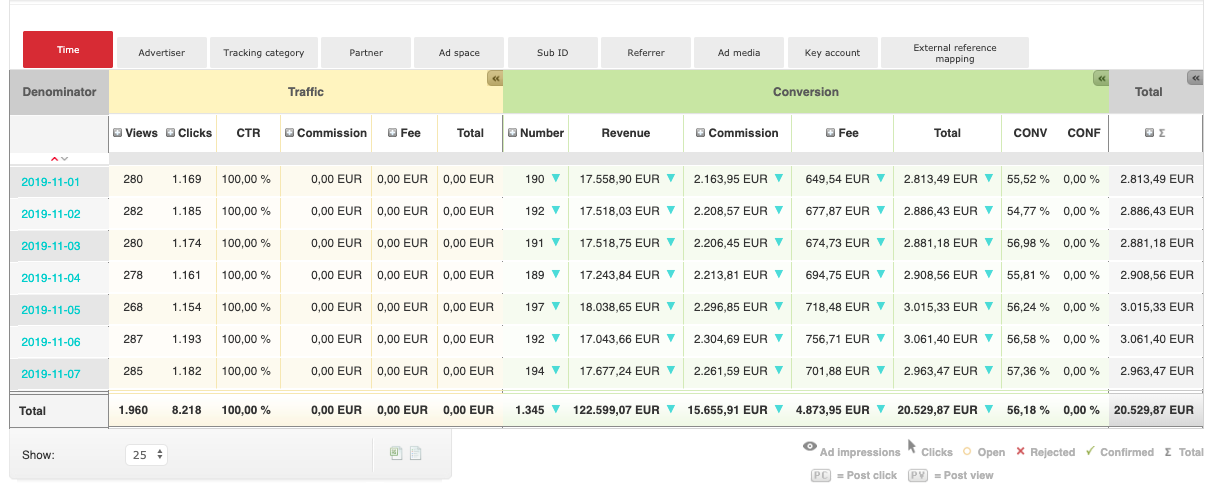To see how your business is doing, start by clicking on ‘reporting’ in the main navigation menu. If you do so, a list will be displayed via which you can preselect the denominator by which you want your report to be displayed. Please note you have the following options:
Time: display your report ordered by day, by week, by month, etc..
Advertiser: display your report ordered by the various advertisers on your platform.
Tracking category: display your report by the tracking categories of your advertisers.
Ad space: display your report ordered by the ad spaces via which your partners are generating conversions.
Sub ID: display your report ordered by the sub IDs your partners have attached to your tracking tags. Please note only sub IDs used for clicks that resulted in conversions will appear in the report.
Referrer: display your report ordered by the original traffic source.
Ad media: display your results ordered by the names and IDs of the banners, text links and HTML items your advertisers provide.
External reference mapping: display your results ordered by the values you have mapped using the external reference tool.
The ‘saved filters’ section has a different function that will be discussed in more detail below.
After you have selected selected the denominator by clicking on it, a page will appear looking more or less like this:

As of now, the page only consists of the filter panel, which will be discussed in more detail below. The actual report will not be shown until you click on the ‘show’ button in the left lower corner of the panel.
The filter options allow you to differentiate your report after you have defined a main denominator. Let’s have a look at all the options:
First, you can specify the timeframe of your report. By default, a report will be generated containing all the conversions you generated during the last seven days. You can select another dynamic timeframe, such as the day before, the current week or the last month. If you are looking for a specific period, use the custom timeframe.
The moment, right below the timeframe option, allows you to display your conversions by the moment they were originally registered, by the date on which they were updated or by the date on which they were paid out, i.e. included in a payment entry. By default, the moment of the initial registration will be selected.
Further to the right, you will find you can filter out conversions related to specific countries, advertisers, tracking categories, conversion targets and ad spaces. When you filter by a specific advertiser, you can choose to display the advertisers on the platform in a list or use a search function. Also note the difference between ‘country’, ‘country of promotion’ and ‘billing country’:
The ‘country’ is the country in which an advertiser is registered, corresponding with the country of the entity. By using this filter, you can check how all your Irish or South-African based advertisers are doing.
The ‘country of promotion’ is the country in which an advertiser is active. An advertiser can be registered in the UK, but active in Ireland as well. By using this filter, you can see how much business you are generating in specific countries.
The ‘billing country’ is the country in which the advertiser is billed. Please note that this option is only relevant when you are invoicing your advertiser.
Some of the denominators have special filters:
If you select ‘time’ as your main denominator, you can define via the ‘output unit’ whether your conversions should be displayed by day, week, month, quarter or year. Please note by default, ‘day’ will be selected.
If you select ‘partner’ and ‘ad media’, you can trim down your report by selecting a specific ‘ad media type’, ‘ad media format’ or ‘ad media kit’.
If you use the referrer denominator you can differentiate between registered and unregistered ad spaces. You can also search for specific referrers using the search box.
If you are done with your filter settings, click on the button ‘show’. You can use the ‘reset’ button anytime to set back the filter settings to the default mode.
Please note that if you need to use a specific combination of filter settings regularly, you can save your filter settings by clicking the ‘save filter’ button. To select the saved filter, click on the ‘saved filters’ under ‘reporting’ in the navigation menu on the left.
Let’s have a look at the actual report now:

As you can see, the denominator of this report is time. The unit of output is day, displayed in the column on the left. To change the denominator quickly, you can use the tabs at the top of the table. If you do this, your filter settings will be kept.
You can see the table contains three main columns: ‘traffic’, ‘conversion’ and ‘total’. They will be discussed individually in the sections below.
The traffic columns contain the following elements:
The number of views generated for the advertisers on your platform, i.e. the number of times an ad media item was displayed on ad spaces. By clicking on the plus icon, you can display the number of views for which commission was granted. Please note this option is only relevant when one or more advertisers are working with a CPM model.
The number of clicks generated for the advertisers on your platform, i.e. the number of times a potential customer clicked on an ad media item. Please note that the figure you see relates to conflated clicks: it represents the result of the click filters you have applied. To see the number of raw clicks, click on the plus icon. By doin so, you will also find the number of clicks for which commission was granted when a CPC model was applied.
The so called click-through-rate (CTR), i.e. the percentage of views that resulted into clicks.
The last columns offer you the total commission amount generated via views and clicks, the total fee amount generated via views and clicks and the these commissions and fees. To differentiate between view and click commission and fee, click on the plus icon. Please note you will only see fee amounts when you invoice the advertiser on your platform and you have created a fee model.
The conversion column contains the following elements:
Under ‘number’, you will find the number of conversions generated for the advertisers on your platform. This number includes all commercial conversions registered as conversion target for your advertisers. Please note it does not include non-commercial conversion targets. For more information, please read this article. By clicking on the plus icon, you can differentiate the conversions by post-click and post-view conversions.
Under ‘amount’, the amount of revenue related to the conversions will be displayed. Via the plus icon you can differentiate the amount in post-click and post-view conversions.
Under ‘commission’, you will find the amount of commission attributed to the conversions. The plus icon allows you to differentiate the commission in post-click and post-view conversions.
Under ‘fee’, you will find the amount of fee attributed to the conversions. Again, the plus icon allows you to differentiate the fee in post-click and post-view conversions. Please note you will only see fee amounts when you invoice the advertiser on your platform and you have created a fee model.
The conversion rate (CONV) is the percentage of clicks that resulted in conversions.
Finally, the confirmation rate (COFN) is the percentage of conversions that have been confirmed during the validation process.
The figure you see under ‘total’ represents the total amount of commission your partners generated, ordered by the selected denominator. Please note the figures you see here can include commission generated for views, clicks and conversions.
Suppose you have created an overview of all the conversions generated via your platform during the last week. Now, you want to see what were the best days and what were the worst. To do this, go over the slim grey bar with your mouse: two little arrows will appear allowing you to sort by the column you have selected, starting either with the lowest value (click on ˆ) or the highest (click on ˇ), more or less as in the following image:
Of course, the other columns will be reordered as well. This function also comes in handy when you want to see what the best performing ad media items are, what ad spaces are driving the biggest amounts of traffic, what advertisers are performing best, etc.
After you have finished the validation process, the report will also allow you to see the number of conversions, the amount, the commission and the fee ordered by status. All you need to do is click on the arrow pointing down next to the relevant figure. When you do this, a panel will appear looking more or less like this:
The figures marked with the yellow circle represent open conversions, the red cross represent rejected conversions, the green check mark confirmed conversions.
To export a report, use the little icons at the bottom of the page:
For a comprehensive overview of the data in these reports, please read the article on the reporting export file.
Views and clicks are updated every hour. A conversion will be visible approximately 15 minutes after it was tracked.